Tapakdore
| This article is a stub. You can help IxWiki by expanding it. |
Queendom of Tapakdore | |
|---|---|
|
Flag | |
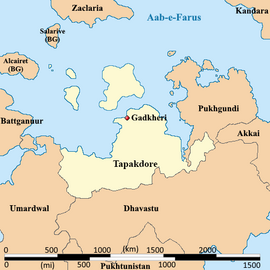 Location of Tapakdore | |
| Largest largest city | Gadkheri |
| Official languages | Tapakdi, Peshbi, Burgoignesc |
| Ethnic groups | Primarily Tapakdan, with minority Peshabi, and Kashmiris |
| Religion | Primarily Buddhism, with minority Sikhism, Hinduism, Jainism |
| Demonym(s) | Tapakdi |
| Government | Monarchy |
| Establishment | |
• Independence | 1811 |
| Area | |
• Total | 728,511.856 km2 (281,280.000 sq mi) |
| Population | |
• 2028 estimate | 48,016,260 |
• Density | 65.910/km2 (170.7/sq mi) |
| GDP (nominal) | estimate |
• Total | $825,895,037,203.20 |
• Per capita | $17,200.32 |
| Currency | Common Middle Sea Florin (CMS ƒ) |
| Driving side | right side |
Tapakdore, officially the Queendom of Tapakdore is a developing nation in the Audonian region of Daria. It is bound by Pukhgundi in the north, Dhavastu in the south, and a small stretch of the southern coast of the Sea of Saksona. Its capital and only coastal region is becoming more heavily urbanized with its interior remaining largely rural.
Tapakdore has an absolute monarchy who fills the role of both legislature and executive, and a supreme court, which has been criticized for being a puppet of the monarch.
It is a member of the League of Nations, the International Red Cross and Red Crescent Movement, and many other international organizations.
It is an emerging market, market economy focused on exports, under the watchful eye of Burgundie whose companies have a massive stake in the country's economic activity. It is an active leader in the Middle seas region's economic activity. Recently, exploration companies from Burgundie have found evidence of deposits of rare earth metals that will be mined in the near future. There are fishing, ship breaking, and recycling economies that Burgundie is also investing in to expand and connect to the global trade network. During the colonial period it was a rich source of rubies and sapphires, many of which are featured in the royal scepter and orb of the Great Prince of Burgundie.
Many scholars have criticized its economic governance and politics, arguing that it is merely a client of the Burgoignesc thalattocracy's economic and cultural might.
The people of Tapakdore are predominantly culturally Tapakdi, Peshabi or Kashmiris, speak Tapakdi or Peshbi, and Burgoignesc, and most practice Buddhism, with minorities of Sikhism, Hinduism, or Jainism adherents.
Demographics
-
Tapakdi schoolgirls
-
Tapakdi monk
-
Tapakdi man
-
Peshabi man
-
Young Peshabi man
-
Hip Peshabi man
-
Peshabi woman
-
Peshabi woman
-
Kashmiri youth
-
Kashmiri man
-
Kashmiri boys
-
Kashmiri schoolgirls
-
Kashmiri men
The people of Tapakdore are predominantly culturally Tapakdi, Peshabi or Kashmiris.
Linguistic Demographics

78.56% of the population can speak Tapakdi, 45.53% of the population can speak Peshabi, and 15% of the population can speak Burgoignesc.
The Tapakdi people who account for 58% of the population of Tapakdore speak Tapakdi as their primary language. The Peshabi community (28.8% of the population) uses Peshabi primarily, but over half also have a proficiency in Tapakdi. Similarly, while Peshabi reigns supreme among the minority Kashmiris, roughly 18% possess the ability to communicate in Tapakdi. Burgoignesc holds the position of the second language due to Tapakdore's strong economic ties with Burgundie. This makes Burgoignesc the language of choice for business and international dealings. Notably, educated professionals across all ethnicities, particularly those in business and government, exhibit proficiency in Burgoignesc. The primary and secondary education system in Tapakdore teaches Tapakdi and Burgoignesc to all students as a separate language course of study, but all other topics are studies in either Tapakdi or Peshabi. In tertiary academic settings courses are taught either only in Tapakdi or Burgoignesc unless the field of study is related directly to the sociology, history, or anthropology of the Peshabi-speaking people.
The Tapadki language while originally and still written in the Tapadki script, has, as of 1994, a Latinized alphabet which is becoming more commonly used.
Religious Demographics
Buddhism is the cornerstone of Tapakdore's religious make up, 46% of the population of the nation are its adherence. Its arrival in Tapakdore came through the conversion of Emperor Ashoka of the Arunid Empire in the 3rd century BCE. Mahayana Buddhism, emphasizing compassion and the potential for all beings to achieve enlightenment, is the dominant school of thought within the country. Buddhism is practiced by all ethnic groups but its ethnographic center is among the Tapakdi people.
Sikhism constitutes a substantial 26.5% of Tapakdore's religious identity. Sikhism's emphasis on social justice, equality, and standing up for the oppressed likely resonated with the Pehsabi people who faced marginalization during the Oduniyyad Calphate. The presence of Sikh Gurus in their disciples in modern Tapakdore is attested to in the 16th or 17th centuries. Peshabi Sikhism was fostered by the Martillian colonizers of the Peshabiwar colony who wanted to ensure that there was no native common cause with the Buddhists in the Duchy of Bourgondi's Pukhgundi colony. However, the establishment of Gurdwaras (Sikh places of worship) across the nation serves as a testament to the faith's enduring presence. The harmonious coexistence of Sikhism with Buddhism in modern Tapakdore is commonly attributed to shared values of compassion, ethical conduct, and a focus on achieving enlightenment. Sikhism is predominately practiced by the Peshabi and to a certain extent Kashmiri people.
Hinduism is practiced by 12.5% of Tapakdore's population. The arrival of Hinduism is also a result of the country being a part of the Arunid Empire. The presence of Hindu temples and iconography in archaeological sites suggests a period of flourishing Hinduism within Tapakdore, perhaps as a rejection of the rise of Zoroastrian influences in the court practices of Buddhism starting in the 4th century CE. However, the court religion, ostensibly being Buddhism, and the influence of Jainism led to a decline in the prevalence of Hinduism over time, which was one of the largest religions outside of Islam in the region under the Oduniyyad Calphate. Nevertheless, Hinduism continues to hold significance for a dedicated segment of the population. Hinduism is strong in the southwest of the country where the populations are majority Kashmiri with some Peshabi people also practicing.
Jainism constitutes 7.3% of the religious population. Jain philosophy, emphasizing strict vegetarianism, ethical conduct, and detachment from worldly possessions, may have attracted individuals seeking a more ascetic way of life, but never drew large numbers to its casue. Considered fringe, fanatic, and fundamentalist by most Tapakdoris, there a few communities along the southern border that are the strongholds of Jainism in Tapakdore.
Christianity, in its various denominations, represents a minority of 5.2% within Tapakdore. Its arrival occurred during the colonial period and missionary activities in the 17th and 18th centuries. They are predominantly Protestant, Mercantile Reform Protestantism is the chief among them. The remaining 2.5% of the population either identify with other religions or do not subscribe to any particular faith. It is mostly practiced along the coast, particularly in the islands of Peshabiwar.
Economy
Tapakdore, is nestled in the Middle seas region, and is known for its rich natural resources and diverse landscape, comprising a pristine coastline in the west, expansive plains in the central region, and a formidable mountain range in the east, where rubies and sapphires are mined. Despite its potential, the nation has faced numerous challenges in developing a robust and sustainable economy.
The mining sector, while a source of valuable gemstones, has been marred by underregulated practices, leading to environmental degradation and exploitation of local communities. However, with the support and guidance from nations like Burgundie and others in the Middle seas region, Tapakdore has been gradually implementing some regulations to foster more ethical and sustainable mining practices. The introduction of modern technologies and the establishment of community development initiatives have begun to transform the mining sector into a more responsible and transparent industry, contributing to the nation's emerging market economy.
The agricultural sector has undergone a significant transformation, with the implementation of modern techniques and infrastructure improvements, also sponsored by Burgundie. The nation's fertile plains have become a hub for the cultivation of a variety of crops, like rice, wheat, and sorghum, ensuring food security and creating opportunities for agricultural exports. With the aid of neighboring countries, Tapakdore has invested in agricultural infrastructure like irrigation and renewable power generation projects.
The manufacturing sector, though in its early stages, has shown promise as the nation endeavors to capitalize on its availability of raw materials. With guidance and investment from the Middle seas region nations and Burgundie, Tapakdore is fostering the growth of local industries, focusing on full-cycle internal products (products whose raw materials are available in Tapakdore, can be turned into finished products in the country, and bought and used by the Tapakdi people) and the development of skilled labor, contributing to the overall economic diversification of the country.
However, one of the more contentious aspects of Tapakdore's economy has been the shipbreaking industry, which, until recently, operated with minimal oversight and safety regulations, posing significant risks to workers and the environment. Recognizing the need for reform, Tapakdore has begun collaborating with its regional partners to implement comprehensive safety measures and enforce stringent environmental standards, ensuring the sustainable development of the shipbreaking sector.
Despite the challenges, Tapakdore's export market has shown promising signs of growth, albeit at a slower pace than anticipated. With the support of neighboring nations in the Middle seas region and Burgundie, Tapakdore is exploring new avenues for expanding its export market, capitalizing on its natural resources and the growing demand for high-tech products. Through collaborative efforts and strategic partnerships, the nation is gradually establishing itself as a reliable exporter of gemstones, agricultural goods, and ethically manufactured products, contributing to the steady progress of its emerging market economy.
Standard of living
In urban areas, particularly the capital and major cities, the standard of living has seen noticeable improvements in the last few decades. Access to basic amenities such as clean water, electricity, and sanitation has become almost ubiquitous, thanks to ongoing infrastructure development initiatives supported by neighboring nations in the Middle seas region and Burgundie. Modern housing complexes and improved urban planning have contributed to a more comfortable and sustainable urban lifestyle.
However, rural areas still grapple with limited access to essential services and infrastructure, posing challenges to the overall standard of living. Despite advancements in the agricultural sector, some remote farming communities continue to face difficulties in accessing quality healthcare, education, and reliable transportation. Efforts to bridge the urban-rural divide have been underway, focusing on improving connectivity and providing targeted support for rural development projects, however, those areas which are deemed as key routes for new infrastructure for developing a stronger export market are being prioritized.
The education sector has also seen significant progress, with increased access to primary and secondary schooling across the nation. Government initiatives, in collaboration with international partners, have aimed to improve the quality of education, focusing on enhancing curriculum standards and providing training for educators. This has opened up new opportunities for the younger generation, enabling them to acquire the necessary skills to contribute to the country's evolving economy. The ultimate goal is to meet the Burgogignesc standard of Total Economic Engagement whereby all able-bodied people in the country are contributing to the nation's economy.
Healthcare services have also undergone significant improvements, with the establishment of more healthcare facilities and the deployment of trained medical professionals in various regions in a capacity building effort to train locals to be medical professionals themselves. Efforts to expand healthcare coverage and promote preventive healthcare measures have led to a reduction in certain preventable diseases and an overall increase in life expectancy.
Despite these advancements, income disparities and socio-economic inequalities remain prevalent, creating challenges in ensuring a consistently high standard of living for all citizens. Efforts to address these disparities are ongoing, with a focus on promoting inclusive economic growth and a sustainable distribution of resources. Through collaborative efforts between the government, international partners, and local communities, Tapakdore continues its journey toward enhancing the overall standard of living and ensuring a better quality of life for all its people.
Employment
Agriculture
Tropical agricultural products: Rice, bananas, coconuts, pineapples, mangoes, sugar cane, and rubber trees. Interior: Sorghum, millet, cotton, peanuts, cassava and sweet potatoes Highlands: apples, pears, peaches, plums, potatoes, cabbage, broccoli, carrots, and tea
Tourism
Agrinergie
Main article: Agrivoltaics
Logging/Mineral extraction
Paper milling
Mining
Drilling
Fishing
Aquaculture
Main article: Aquaculture Aquatic life farming, in general
- Pisciculture- fish farming
- Mariculture- Saltwater fish farming
- shrimp farming
- oyster farming
- algaculture
Trade
Infrastructure
Rail
Tapakdore uses Standard gauge, 1,435 mm (4 ft 8+1⁄2 in) as most of its rail infrastructure has been under the auspices of Burgundie and its sphere of influence in the Middle seas region, who all use that rail gauge.
Roads
Louage
A louage is a minibus shared taxi in many parts of Daria that were colonized by Burgundie. In Burgoignesc, the name means "rental." Departing only when filled with passengers not at specific times, they can be hired at stations. Louage ply set routes, and fares are set by the government. In contrast to other share taxis in Audonia, louage are sparsely decorated. Louages use a color-coding system to show customers what type of transport they provide and the destination of the vehicle. Louages with red lettering travel from one state to another, blue travel from city to city within a state, and yellow serves rural locales. Fares are purchased from ticket agents who walk throughout the louage stations or stands. Typical vehicles include: the MILCAR Jornalero, the TerreRaubeuer Valliant 130, and the CTC M237-07.
Maritime
Air
Energy and electricity
Phone service and internet
Geography
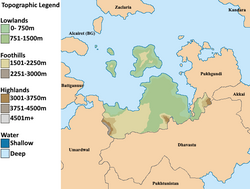
Climate and environment
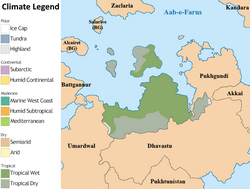
Government and Politics
Subdivisions
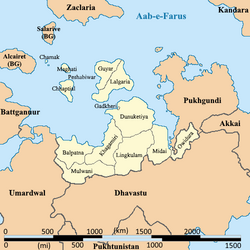
- Balpatna
- Chamak
- Chhaptial
- Dunuketiya
- Gadkheri Capital District
- Guyar
- Khagamiri
- Lalgaria
- Lingkulam
- Maghati
- Midai
- Mulwani
- Owidura
Military
Tapakdore maintains a modestly sized military force, primarily focused on safeguarding national security and protecting the country's borders. The number of eligible candidates are limited by the significant portions of the population being religiously non-violent. The composition of the military reflects a balance between ground forces, maritime defense capabilities, and a small air force contingent.
Royal Army
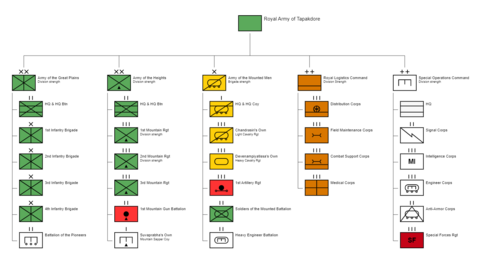
The Royal Army of Tapakdore, consisting of specialized divisions and brigades, has leveraged surplus military materiel from nations in the Middle seas region and Burgundie to bolster its defense capabilities. The Army of the Great Plains, the Army's motorized infantry division is postured to operate across expansive terrains of the western and central parts of the country, has been equipped with surplus motorized vehicles, including trucks, armored personnel carriers, and utility vehicles, sourced from friendly or sympathetic nations. This surplus materiel has significantly enhanced the mobility and operational effectiveness of the division, enabling rapid deployment and maneuverability on the plains. The Army of the Heights, specializing in mountain warfare, has benefited from surplus cold-weather gear, specialized mountaineering equipment, and rugged terrain vehicles procured through collaborative agreements with Burgundie. These provisions have equipped the division to effectively navigate and operate in challenging mountainous environments, ensuring the readiness of Tapakdore's forces in high-altitude regions along its border with Pukhgundi in the east.
The Army of the Mounted Men is the Army's armored cavalry unit, enhancing the Army's direct and indirect firepower and reconnaissance capabilities. It consists of a light and a heavy cavalry regiment, the former a wheeled unit used primarily for force recon following Burgoignesc doctrine and the latter a heavier, tracked unit with AMY-82 tanks supplied by Burgundie (which it purchased from Yonderre when that country began replacing them in 2016) that is used more for direct engagements with its neighbors, should they invade.
Moreover, the training and advisory support provided to the Royal Army of Tapakdore have been primarily facilitated by the Treaty Observation Corps of the National Gendarmerie of Burgundie. This collaboration has enabled the Tapakdorean forces to benefit from advanced military training programs, tactical expertise, and strategic guidance, fostering the professional development of the army personnel and enhancing their operational readiness. The expertise shared by the Treaty Observation Corps has contributed to the modernization and professionalization of the Tapakdorean military, strengthening its capacity to respond effectively to evolving security challenges in the region.
Royal Maritime Defense Force
Tapakdore maintains a small but competent naval/coast guard fleet responsible for safeguarding the nation's limited coastal waters and maritime interests. This naval force focuses on maritime surveillance, coastal defense, and sovereignty patrols, ensuring the security of it's territorial waters.
Royal Air Force
The Tapakdi Royal Air Force comprises a modest fleet of aircraft, including transport planes and a limited number of fighter jets for air defense purposes. The air force is primarily tasked with conducting aerial surveillance, providing logistical support for ground operations, and ensuring the protection of Tapakdore's airspace.
Tapakdore maintains a non-aggressive stance in regional affairs, prioritizing diplomatic solutions and peaceful coexistence with its neighboring countries. The nation actively participates in international peacekeeping missions, showcasing its commitment to global security and stability. Furthermore, Tapakdore fosters cooperative defense initiatives and partnerships with neighboring nations and international organizations, emphasizing the importance of collaborative security measures and mutual defense agreements in the Middle Seas region.
Law Enforcement
Tapakdori National Gendarmerie
History
Prehistory
Battganuur was originally settled by Indo-Aryan peoples who likewise settled areas from Zaclaria to Pukhgundi. These people shared languages with common roots, the Indo-Aryan languages which later diverged into Proto-Umardonian (west of the Sindhus River) and proto-Sindhus (east of the Sindhus River).
Umaronid Empire
Classical Antiquity
Arunid Empire
Golden Age
Denoted as starting with the Muhammadian conquest of the city of Ramsakhs in 670s and ending at the fall of the Oduniyyad Caliphate in 1517, the Golden Age of Audonia had a sweeping effect on the area of modern Battganuur. When it was conquered by the Oduniyyad Caliphate in the 700 and 800s the area was generally already very developed and it took a lot of time and effort to convert the area to Islam.
Warring Century
Colonial era

*Red- Barbary Straits colony
*Green- Kandahari-Pukhtun colony
*Blue- Peshabiwar colony
*Purple- Pukhgundi colony
Starting with the fall of the Oduniyyad Caliphate in 1517 and lasting until the expulsion of the Marialanii Ularien Trading Company in 1836 and the Bourgondii Royal Trading Company in 1842, the early modern era in Battganuur was characterized by rapid development, and unprecedented resource and human exploitation.
Peshabiwar colony
Colony of the Duchy of Martilles: 1592-1807
Kandahari-Pukhtun colony
Colony of the Duchy of Bourgondi: 1615-1831
Pukhgundi colony
Colony of the Duchy of Bourgondi: 1635-1811















